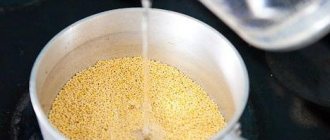Section: News
Category: Food
Back in the 19th century, Count D.A. Guryev, who was also known as a gourmet, was invited to dinner with officer Yurisovsky. The dessert he tasted amazed him so much with its taste that Guryev kissed the cook, Zakhar Kuzmin, who prepared this extraordinary dish. And for dessert, semolina porridge was served, which later received the name Guryevskaya. The name of the cook was forgotten over time, but the recipe for Guryev porridge was included in almost all cookbooks and is known today far beyond the borders of Russia.
How to cook Guryev porridge?
Traditionally, Guryev porridge is prepared from semolina with the obligatory addition of foam, which is skimmed off the milk or cream when heated. Then the foams, alternately with semolina porridge and nuts, are laid out in layers in a baking dish or stewpan and baked in the oven. The top of the porridge is decorated with candied fruits, nuts and poured over with jam. Before adding nuts to Guryev porridge, they must be cleared of films so that the dish does not acquire a gray color and spoil the entire aesthetics of the dish.
Excursion into history
The history of Guryev porridge is so amazing that it seems incredible. Finance Minister Guryev, a man who knows a lot about profitable investments, did not consider it wasteful to give a measure of gold (26 liters of gold chervonets, each weighing 3.39 g) for the cook Zakhar Kuzmin, who came up with the recipe for this dish, and his family.
It must be said that Count Guryev made the right decision, since Alexander III, Count Witte and other members of the aristocracy loved the delicacy so much at the royal court that soon the porridge began to be called the “queen of desserts.”
The official presentation of Guryev porridge took place in 1814, when it was presented in Paris as a “Russian dessert.” Since then, this dish has become the hallmark of Russian cuisine.
Step-by-step recipe with photos
A little history.
It is considered a traditional dish of Russian cuisine, but was invented only at the beginning of the 19th century.
The name of the porridge comes from the name of Count Dmitry Guryev, Minister of Finance and member of the State Council of the Russian Empire. It was invented by Zakhar Kuzmin, the serf cook of the retired major of the Orenburg Dragoon Regiment Georgy Yurisovsky, with whom Guryev was visiting[1]. Subsequently, Guryev bought out Kuzmin and his family and made him the full-time cook of his yard. According to another version, Guryev himself came up with the recipe for porridge. This dish was the most favorite on the menu of Emperor Alexander III. Before the train crash in 1888, the emperor was served this very dish for dessert. When the waiter approached the emperor to add more cream, a terrible blow occurred and the train derailed.
Guryev porridge is prepared using kaymak or foam skimmed from cream poured into a wide frying pan. The resulting foams are laid out in layers in a wide saucepan, alternately with boiled thick semolina porridge mixed with crushed nuts, and brought to readiness over low heat in the oven, after which they are decorated with dried fruits or jam on top.
Classic recipe for Guryev porridge
Preparing semolina porridge according to this recipe is a fairly long process. But as a result, a simple dish turns into an exquisite dessert.
Its ingredients are:
- 1300 ml milk;
- 100 g semolina;
- 100 g walnuts;
- 50 g raisins;
- 150 g sugar.
Cooking step by step:
- Preparing the nuts. First, they should be poured with boiling water for three to four minutes so that the thin brown crust can be easily removed. The peeled fruits should be dried on a towel, then crushed into crumbs (for example, using a meat grinder), mixed with 50 g of sugar and baked in the oven for three minutes at 200°C.
- Raisins, like nuts, need to be poured with boiling water for about ten minutes. Once the dry grapes have steamed, it's time to dry them with paper towels.
- Pour the milk into a heat-resistant container and place in a hot oven, where it simmers until a thick milky crust forms. It should be carefully removed and transferred to a separate plate. It is necessary to obtain five or six such films during the simmering process.
- Pour the remaining milk into a saucepan, bring to a boil, add semolina and 50 g of sugar. After this, the semolina is cooked like regular semolina porridge.
- Set aside a couple of tablespoons of baked nuts for decoration, mix the remaining nuts and raisins with the finished porridge.
- Place 1/6 of the porridge in a beautiful, deep, fireproof bowl, cover with film and repeat this step sequentially with all the films. Sprinkle the top layer of porridge with the remaining 50 g of sugar and place in the oven for 10 minutes. Temperature – 200 degrees. Cook until it has a nice caramel crust.
Guryev porridge for breakfast, like for a holiday
Products:
- semolina - 3/4 cup
- eggs - 2 pcs.
- sugar - 0.5 cups
- milk - 2 cups
- butter - 2 tablespoons
- almonds - 50 g
- vanillin - 5 g
- canned fruits - to taste
Preparing the recipe:
Bring the milk to a boil and add sugar and vanillin. Then gradually add semolina and, stirring, cook for 10 minutes.
Put butter and raw eggs into the cooked porridge, mix everything well and place in a frying pan, previously greased with butter.
Sprinkle sugar on top and place in a hot oven. Readiness is considered to be the formation of a light brown crust on the surface of the porridge.
When serving, garnish the porridge with canned fruit and sprinkle with toasted almonds. Guryev porridge is ready.
From the article you realized that there are many options for preparing Guryev porridge, but there is only one classic recipe. Guryev porridge is a holiday for the body.
Ekaterina ZAYTSEVA
TSAR-PORRIDGE
I have been deceived by my heart, I have been deceived by my mind, But never before, friends, have I been deceived by my stomach. Everyone must admit that, Lover, or poet, or warrior, - Only a carefree gastronome is worthy of the name of the wise.
E.A. Baratynsky. Feasts. 1821(?)
The history of the creation of Guryev porridge is ambiguous and contradictory. For modern people, porridge is associated primarily with a healthy breakfast. Or a side dish for the second course. All the more amazing is the recipe, which has become a national brand. The famous Guryev porridge, rightly called “Tsar Porridge,” is the standard of excess in the domestic culinary tradition. Sugar, baked cream, dried fruits, caramelized nuts, apricot sauce... Just the literal materialization of the sweet life! And the end result is an incomparable dessert that has no analogues in the cuisines of the world.
GURYEV THE FATHER OR GURYEV THE SON?
The history of the creation of Guryev porridge is ambiguous and contradictory. According to one version, the sweet dish was invented by the Minister of Finance of Russia, Count Dmitry Aleksandrovich Guryev (1758-1825) in honor of the victory over Napoleon I Bonaparte. According to another, the dessert was prepared by the serf cook Zakhar Kuzmin for a gala dinner at the retired major of the Orenburg Dragoon Regiment Georgy Vladimirovich Yurisovsky, to which Count Dmitry Alexandrovich was also invited. His Excellency liked the porridge so much that he bought the serf cook and his family. The magazine “Historical Bulletin” for 1900 published a bill of sale dated 1822, according to which the retired major sold “two men, four women and one child” to Count Guryev. But Odessa residents are still convinced that the king-porridge was invented by Count Alexander Dmitrievich Guryev, the eldest son of the minister, when he was the mayor of Odessa...
Be that as it may, the sweet recipe quickly spread throughout the living rooms of noble and wealthy people. After all, not everyone could afford semolina (the main ingredient of the dish), a cereal made from durum wheat; it has historically been considered expensive and rare in Russia. (Modern semolina, well known to us, is much inferior to its predecessor in quality and taste). For example, Lieutenant of the Life Guards and future St. Petersburg governor Pyotr Pavlovich Durnovo is a great gourmet! - with enviable regularity he treated guests to porridge-dessert in his aristocratic mansion on the English Embankment in St. Petersburg. The family culinary chronicle of 1857-1858 speaks for itself: Tsar porridge was served on October 11 and 31, November 19 and 27, December 13, 10, 20, 22 (“semolina porridge with compode”) and January 27, March 5 and 28 (1).
Meet the minu of one of these high-society dinners for five people:
Mashed potato soup Stuffed whitefish Sirloin in English, side dish potatoes and peas Fried vendace Cauliflower Guryev porridge (2).
A SOVIET CHILDHOOD DELICK
There is no canonical recipe for preparing Guryev porridge - this is precisely its special charm. The dish, a collective, exaggerated image of sweet Russian cooking, is interpreted differently by chefs. Some people add nuts and fresh berries, others use all kinds of candied fruits and powdered sugar, and for flavor - a vanilla stick and rum. Only semolina and skimmed milk foam remain unchanged.
In the laconic recipe, which we took from the once popular “Book on Tasty and Healthy Food,” the authors suggest garnishing Guryev porridge with canned fruit. Many people probably associate this delicacy with the recent Soviet era. And the taste of childhood, when dad brought the treasured jars of sugar peaches and pineapples...
Guryevskaya porridge
Add sugar and vanillin to boiling milk. After this, gradually add semolina and, stirring, cook for 10 minutes. Put butter and raw eggs into the cooked porridge, mix it all well and put it in a frying pan, pre-greased with butter, sprinkle with sugar and place in a hot oven. When a light brown crust forms, the porridge is ready.
When serving, garnish the porridge with canned fruit, pour over sweet sauce and sprinkle with toasted almonds. For 3/4 cup semolina - 2 eggs, 1/2 cup sugar, 2 cups milk, 2 tbsp. tablespoons butter, 50 g almonds, 1/2 vanillin powder, 1/2 cans of canned fruit (3).
“HOMEMADE, FRESH, HEALTHY SUPPLIES”
Guryev porridge has become an integral part of our historical past. It is known that it was one of the favorite dishes of Emperor Alexander III. During the fateful train journey in 1888, when the Tsar’s train derailed at the Borki station near Kharkov, the Tsar was just pouring cream on the porridge. By a fatal coincidence, the carriages containing the emperor's bedroom and office were completely destroyed, but the dining carriage was not damaged. The emperor later recalled more than once how porridge saved his life.
And we certainly cannot escape from the original Russian porridge! And if only from her...
I look around the table and see different dishes. A flower garden arranged in a pattern. Crimson ham, green cabbage soup with yolk, Ruddy-yellow pie, white cheese, red crayfish, Like pitch, amber - caviar, and with a blue feather there is a motley pike: beautiful! Beautiful because they attract my eyes and taste; But not with an abundance or seasoning of foreign countries, But what neat everything represents is Rus': The food is homemade, fresh, healthy.
Well, how can you disagree with Gavriil Derzhavin?!
AND THERE IS A RECIPE. Tastier than any ice cream...
Yes, it sounds incredible: Guryev porridge can be served as ice cream. We find an amazing recipe in the wonderful book by Elena Romanovna Mushkina “The Secret of the Courland Pie”:
GURYEVSKAYA PORridge FROZEN
Products: semolina - 200 g, butter - 100 g, regular cream - 1 bottle, heavy cream - 100 g, milk - 2 bottles, sugar - 200 g, walnuts (with shell) - 800 g, candied fruits - 200 g , vanilla stick, oil of Provence, rum, lemon juice, salt.
Boil milk and add semolina to it. Stir with a spatula until the porridge thickens and the cereal becomes soft. Add the butter, breaking it into pieces, sugar, a pinch of salt, and a vanilla stick, cut lengthwise. Stir well. Cover the pan tightly with a lid and steam (in a frying pan with hot water) in a medium-temperature oven for half an hour. During this time, prepare the foam. Pour a bottle of regular cream into a spacious, shallow saucepan, put it in the oven over medium heat, and if possible, in a Russian oven. As soon as a golden foam forms on the surface of the cream, carefully remove it with a fork or slotted spoon onto a plate. Place the cream back into the oven until a new foam appears. Do this until all the cream turns into foam and only a thick sediment remains at the bottom of the saucepan. Remove the porridge from the oven, mix with all the skimmed foam, which must first be cut into small pieces; by this time they will have frozen. Remove the vanilla from the porridge and add the thick sediment remaining at the bottom of the saucepan, as well as the caramelized walnuts. Peel the nuts and place in the oven over low heat. Lightly fry to remove the skin, or simply scald with boiling water. Let stand covered for 10-15 minutes. Then peel and dry a little on the stove. For caramel, pour 100 g of sugar into a saucepan, squeeze a few drops of lemon juice into it, and place the saucepan on the stove over high heat. Stir the sugar with a spatula until it turns into a thick, dark red syrup. Pour nuts into the resulting caramel. Stir quickly. Place the nuts on a plate greased with Provençal oil. When cool, break into small pieces and mix with porridge. Then add candied fruits, cut into small cubes and sprinkled with rum, into the porridge. Stir and add 100 g of heavy whipping cream. Mix well again. Place in a thick copper pan or ice cream maker and cover tightly with a lid. “Coat” the lid with oil and ice with salt. Keep in the cold. After two hours, rinse the mold thoroughly with cold water. Serve the porridge on a platter like ice cream (4).
1 Lotman Yu.M., Pogosyan E.A. High society dinners. Panorama of metropolitan life. St. Petersburg: Pushkin Foundation, 2006. P. 128,138,163,170,191, 228,237,239,246,288, 310. 2 Ibid. P. 228. 3 A book about tasty and healthy food. M., 1953. P. 323. 4 Mushkina E.R. The secret of the Courland pie. M., 2008. pp. 55-56.
"Motherland". – 2020. - No. 7. – pp. 77-79.
Many people know Guryev porridge, the recipe for which came to us from the 19th century. It is believed that Guryev porridge was one of the favorite dishes of the royal cuisine, although it is ordinary semolina porridge. But one that has turned from everyday food into a real dessert, very tasty and healthy. Properly prepared, this dessert can be a decoration for any feast; it can be served for breakfast; this dish will certainly delight both children and adults. To prepare it, you can use various ingredients: dried fruits, nuts, any types of jam, fresh berries and fruits.
Housewives often look for new recipes to surprise and delight their loved ones. Let's take porridge, for example. It’s very easy to cook porridge in a slow cooker, but sometimes you want to create something unusual. Such dishes include the preparation of Guryev porridge.
So, the basic rules of preparation are that, first of all, milk foam is prepared in the required quantity. The foam is collected from the cream, which is simmered in the oven, while the cream becomes melted, with a characteristic taste and aroma, a delicate cream color. Next, after the foam has been removed from the cream several times and there is enough of it, semolina, a pinch of salt and sugar are poured into the cream.
The cereal is cooked until tender, like regular semolina porridge. At this time, the fillings are prepared: dried fruits, nuts, fruit and berry fillings. The finished porridge is laid out in layers: porridge - foam - dried fruits - porridge - foam - berry filling and so on, as many layers as you want. After that, everything goes into the oven, where it is baked until done.
Ingredients:
- semolina - 200 g;
- cream 33% - 800 ml;
- salt on the tip of a knife;
- sugar - 2 tbsp. spoons;
- raisins - 0.5 cups;
- dried apricots - 0.5 cups;
- walnuts - 0.5 cups.
Pour the cream into a wide container, such as a frying pan, and place in an oven preheated to 160 degrees. When a nice fluffy foam appears on the surface of the cream, carefully remove it with a spoon or slotted spoon and place it on a dish. The pan with the cream continues to remain in the oven.
After the foam appears, remove it again to the dish, continue until there is enough foam, it is better to do this 5 or 7 times. Then remove the pan from the oven, put it on the stove, bring the cream to a boil and pour semolina and salt into it and sugar. Stirring continuously, cook the semolina porridge until tender.
Rinse raisins and dried apricots thoroughly and pour boiling water for 20 minutes. After this, drain the water and chop the dried apricots. Walnuts should be shelled and crushed in a mortar or blender finely enough so that the finished dish is tender.
Now grease the baking dish with butter, put a layer of porridge in it, then a layer of foam, and then a layer of raisins; again a layer of porridge, a layer of foam, a layer of dried apricots; then again a layer of porridge, a layer of foam, a layer of nuts. The last layer should be a layer of porridge, sprinkled with sugar.
After this, place the pan in the oven, preheated to 180 degrees, and bake until the sugar forms a golden brown crust, about 10 - 15 minutes. Remove the finished dish from the oven, cut into pieces, and garnish with fresh mint leaves.
It is very good to use different types of jam as layers. Strawberry is especially suitable, because it is so aromatic, has a unique sweet and sour taste, probably everyone loves it. You can also use apricot jam, plum jam, honey.
There are recipes for making Guryev porridge with fresh berries and fruits. To do this you will need a glass of fresh berries or fruits. This could again be strawberries, apricots or apples. In this case, apples should be peeled, cored and finely chopped. Remove pits from apricots and chop finely.
Place the fruits prepared in this way in a frying pan, add 2 tablespoons of sugar, 1 tablespoon of starch and simmer lightly over low heat. Starch is added to thicken the filling and prevent it from leaking. After the sugar has melted, the finished filling should be laid out as the next layer.
How to cook in a slow cooker
The slow cooker produces excellent Guryev semolina porridge in its modernized and simplified version.
To do this you will need:
- 500 ml milk;
- 100 g semolina;
- 50 g sugar;
- 25 g vanilla sugar;
- 2 eggs;
- 50 g crushed walnuts;
- 200 g of fresh fruit or jam;
- 20 g butter;
- 3 – 4 g salt.
How to cook:
- Cook porridge from milk, vanilla sugar, salt and semolina in a multicooker using the “Milk porridge” or “Stew” option. Transfer the finished porridge from the multi-pan to allow the dish to cool.
- Beat the eggs with sugar into a fluffy foamy mass, which should be carefully mixed into the already cooled semolina porridge along with the chopped nuts.
- Grease a clean and dry multicooker bowl with a piece of soft butter. Place a quarter of the porridge in a layer on the bottom, layer it with fruit or jam and repeat this several more times.
- Close the lid of the device and start the “Porridge” program. Before serving, decorate the finished dish with fruit.
Guryevskaya porridge with orange
The porridge can be given a pronounced citrus taste, which is combined with vanilla aroma.
Ingredients:
- 0.5 l of milk;
- half a glass of semolina;
- half a glass of any nuts;
- half an orange;
- 1 tbsp sugar;
- 1 raw egg;
- 50 ml cream;
- a pinch of salt;
- a pinch of vanillin.
Preparation:
- Boil the milk. Add a pinch of salt.
- Pour semolina into boiling milk in a thin stream. Stir constantly throughout cooking.
- Cook the porridge for 2 minutes. Let it cool and add chopped nuts.
- In a separate container, mix the yolk with sugar.
- In another container, thoroughly beat the egg whites. A foam should form.
- Pour both the yolk and white into the porridge. Add nuts there and add a pinch of vanillin.
- Cut the orange into thin slices.
- Place layers in a fireproof form: porridge, orange, brush with cream, porridge.
- Bake in the oven for 20 minutes at 170ºC.
An old recipe from the 19th century
The 19th century (more precisely, 1899) was marked by the publication of the book “Practical Fundamentals of Culinary Art,” which contains an ancient recipe for this delicacy.
What distinguishes it from later variations is the fact that it is served in a cast iron frying pan, as well as the use of kaymak and maseduan for the layer.
The proportions of ingredients used in preparing the dish will be as follows:
- 1500 ml heavy cream;
- 500 ml milk;
- 90 g semolina;
- 350 g granulated sugar (including 50 g for semolina);
- 20 g vanilla sugar;
- 600 ml water;
- 100 g chopped nuts (almonds, hazelnuts);
- 500 g apples and pears.
Sequence of culinary processes:
- We prepare kaymak - films of cream stewed in the oven. Cream with a fat content of 20% or more should be poured into a cast-iron frying pan with high sides and a thick bottom, and then placed in a preheated oven. The temperature in it should be such that they do not boil, but slowly simmer. The resulting films must be carefully removed and placed on separate flat plates. Foam from boiled cream not only gives the porridge a delicate creamy taste, but is also rich in iron, vitamin A and calcium. During the cooking process, it is important not to overcook them until they turn brown, as such foams will taste bitter.
- While the cream is simmering, you can boil the milk. Then pour semolina mixed with regular and vanilla sugar into it in a thin stream. Boil the porridge for just a few minutes after boiling, then remove from the heat and leave to simmer, wrapping the pan in a warm blanket.
- Make syrup from water and sugar. Dip apples and pears cut into thin slices into it. Boil the fruit in a boiling mixture for 10 minutes, after which the maseduan (fruit boiled in syrup) for the layer is ready.
- When all the components of the dish are ready, place layers of foam - porridge - maceduan and crushed nuts - porridge - foam on the bottom of the baking dish. It is important to lay the layers in this order. The last layer should be a layer of porridge, sprinkled with nuts and covered with fruit in syrup.
- All that’s left to do is bake the “assembled” porridge in the oven at 100 degrees.
Serve it warm, cut into portions and top with jam or other sweet sauce.
Note to housewives
Today, there are many variations of the classic recipe, guided by which you can significantly diversify and improve the taste of the final dish.
To make Guryev porridge really tasty, you can use some tips proven by centuries of experience, namely:
- walnuts must be roasted before crushing them and using them as an ingredient in Guryev porridge;
- if you decide to use honey and jam as an addition, it is recommended to serve them with an already prepared dish so as not to interrupt the necessary taste and aroma of the cream;
- It is recommended to serve porridge to the table using the same container in which it was prepared, so for these purposes it is initially better to use portioned pots);
- As additional ingredients that can improve the taste and aroma of the dish, you can use orange zest, cardamom, a small amount of rum and cinnamon.
Cooking Guryev porridge is a rather labor-intensive process that requires a lot of time. But after enjoying the results of your labors, you will not regret a single minute spent, because Guryev porridge is an incredibly satisfying, healthy and tasty dessert.
Buckwheat porridge in Guryev style
There is not only Guryev semolina porridge, there is also a less popular version of Guryev-style buckwheat porridge with mushrooms and brains:
- 300 g buckwheat;
- 600 ml mushroom broth;
- 40 g butter;
- 5 g salt;
- 100 g carrots;
- 50 g mushrooms;
- 30 ml vegetable oil;
- 300 g pork or beef brains.
Progress:
- Boil mushroom broth, salt it, add prepared buckwheat and add butter. Mix everything well, cover and simmer over medium heat until half cooked.
- Fry the carrots turned into shavings and mushrooms chopped into thin slices in a frying pan with vegetable oil.
- Place buckwheat porridge, fried carrots and mushrooms and brains in layers in a clay pot. They should be the last layer.
- Cover the pot with a lid and bake in the oven until all components of the dish are cooked. Buckwheat should become crumbly.
Guryev porridge from Alexandrova-Ignatieva
Today I will prepare Guryev porridge in a modern version, based on the recipe of Pelageya Alexandrova-Ignatieva from the textbook for cooks “Practical Fundamentals of Culinary Art,” but with some adjustments.
Instead of “maceduan” (the so-called fruit cut into slices, boiled in sugar syrup, often with the addition of liqueur), I suggest using candied fruits. And to create a glossy crust, we will use modern equipment - a gas burner instead of a “hot salamander” (the so-called metal plate that was applied to sugar to melt it).
From tops and greens
Along with the above recipe for Guryev-style buckwheat porridge, there is also a lean version with beet tops and herbs.
Beet tops contain so many vitamins and beneficial micro- and macroelements that they will help the body cope with stress during Lent.
List of required ingredients:
- 210 g buckwheat;
- 400 ml water;
- 100 g beet tops;
- 50 g dill;
- 50 g parsley;
- salt to taste.
Preparation:
- Wash the tops and finely chop them. Sort the grains and rinse in cold water.
- Bring water to a boil, add buckwheat and chopped tops to it. Mix everything, cover and simmer for a quarter of an hour.
- Then remove the almost finished porridge from the heat and, without opening the lid, let it stand for another 10 minutes.
- Before serving, add chopped fresh herbs (dill and parsley) and stir.
Guryev porridge with vanilla flavor
A bouquet of spices imparts a slightly tart aroma. An assortment of nuts makes the porridge especially satisfying. If it is not possible to use several types of nuts, then you can prepare porridge with just one variety.
Ingredients:
- 30 gr. nuts: almonds, hazelnuts and walnuts;
- 30 gr. raisins;
- 100 ml cream;
- half a glass of semolina;
- 4 tbsp jam or jam;
- frozen or fresh berries;
- vanillin, cinnamon, nutmeg - to taste.
Preparation:
- Grind half the nut mixture, fry the other half with sugar.
- Soak raisins in hot water for 10-15 minutes. To reveal its aroma, you can add 2 cloves.
- Bring the cream to a boil.
- Add semolina in a thin stream, stirring constantly. Cook the porridge for no more than 2 minutes.
- Remove the porridge from the heat, add spices, raisins (they need to be squeezed out of the water) and chopped nuts.
- Place layer by layer in a baking dish: porridge, jam, porridge again.
- Bake for 15 minutes at 180ºС.
- Place fried nuts and berries on the prepared porridge.
How can you diversify a dish?
Guryev semolina is good because it allows you to significantly diversify its composition.
Since there are no strict rules regarding the ingredients used, you can put in it:
- various nuts (walnuts, pine, almonds, hazelnuts, hazel);
- fruits and berries, which can be fresh, boiled in syrup or in the form of jam, or candied fruits (dried fruits).
- You can also layer the porridge with liquid honey.
- Sauces with which you can serve porridge can add variety to the dish. Count Guryev's cook prepared a sauce from chopped apricots for this delicacy. And modern housewives can serve porridge with any sweet sauces, condensed milk, liquid honey or custard.
The presentation of the dish itself can be varied. In the 19th century, this porridge was often offered instead of ice cream. For this purpose, after cooling, it was placed on an icebox, and then cut into portions and served with fresh fruit. Nowadays, in many restaurants of Russian cuisine, Count Guryev’s favorite delicacy is served to guests in large portioned cast-iron frying pans, hot or warm.
The variety of ingredients and sauces used, as well as the presentation itself, has led to the fact that every housewife can have her own Guryev porridge, completely satisfying her family’s taste preferences.
Guryev porridge in a slow cooker
Household appliances simplify the cooking process. And even when preparing such a difficult dish as Guryev porridge, you can save a lot of time.
Ingredients:
- half a glass of semolina;
- 1 liter of milk;
- half a glass of sugar;
- berry jam;
- 50 gr. butter;
- nuts - walnuts or almonds.
Preparation:
- Pour milk into the multicooker bowl.
- Set the “Quenching” mode.
- Skim off the foam 20 minutes before cooking.
- When finished, pour the semolina into the milk.
- Set the “Quenching” mode again.
- Take out the semolina porridge. Place butter on top.
- Wash the multicooker bowl. Coat the inside with butter and place the porridge butter side down. Spread jam on top.
- Set the “Baking” mode, time 20 minutes.
- If you get more porridge, then you can lay it in several layers, alternating it with a layer of butter and jam.
- After cooking, remove the porridge and sprinkle nuts on top.
Ordinary semolina porridge can be turned into real art with the help of additional ingredients. Guryev porridge is one of the unique dishes of Russian cuisine, which has no analogues in the recipes of other countries.
Preparation
Cook thick semolina porridge (take the smallest grains, from soft wheat!). Pour the milk into a saucepan and bring to a boil on the stove. While stirring, add semolina in a thin stream and add a pinch of salt. Cook, stirring, until the porridge thickens. Add sugar and vanilla sugar, a piece of good butter to the porridge. Wrap the stewpan in a blanket and leave it to rest.
Scald the nuts and remove thin skins. I took hazelnuts and almonds. I chopped the nuts coarsely, sprinkled them with sugar (1 tbsp) and fried them in the oven until a light brown caramel crust formed.
Pour the cream into a wide, shallow ovenproof dish (I used a cake pan). And put in the oven at 150-160 degrees.
Our task is to prepare a traditional Russian baked milk product. When a golden foam appears on the surface, carefully remove it with a fork onto a plate, and return the cream to the oven until a new foam appears. Do not over-expose, because dark brown foams are bitter.
When everything is ready, you can start assembling the porridge. Take a metal or other baking dish so that you can put it on the table later. Grease the bottom with a little butter and sprinkle with breadcrumbs. Place a layer of porridge.
Next is a row of foams (the thicker the layer of foams, the tastier). And on top - a row of caramelized or roasted nuts and candied fruits.
Alternate until you run out of food and space in the mold, that is, put the porridge again, a layer of foam, filler... The last layer is porridge. Sprinkle cane sugar on top and burn with a gas torch. Place the pan in the oven (which is still cooling). Here, do not repeat my mistake, do not fill the mold to the brim, otherwise the semolina may run off onto the baking sheet a little (the porridge will rise to the top).
Best served warm, garnished with remaining nuts. When the porridge cools, it will hold its shape well when cut, and will taste more like pudding. If desired, you can complement the dessert with warmed apricot puree or fruit juice. Bon appetit!











